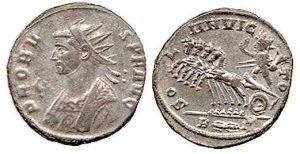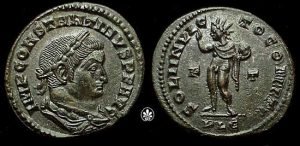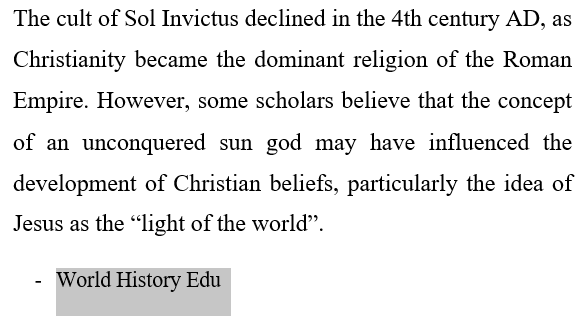Sol Invictus: The Unconquered Sun Deity in Ancient Roman Religion

Many Roman Emperors of the 2nd and 3rd centuries developed quite a devotion to Sol Invictus. Image: Roman Imperial repoussé silver disc of Sol Invictus (3rd century)
In the later Roman Empire, the worship and cult of the Roman god Sol Invictus became prominent. Revered as the patron deity of the sun, he was worshiped as a symbol of light, power, and invincibility. This explains why a good number of Roman generals and emperors, most famous among them Emperor Aurelian, chose him as their patron deity.
Meaning of his name
Sol Invictus is a Latin phrase that means “Unconquered Sun”, with invictus being the Latin word for “unconquered” or “invincible”, while sol was simply “sun”. It must be noted that Romans used the epithet “invictus” for many traditional state deities like Apollo, Mars, Silvanus, and Jupiter.
Origin story
It is likely that the deity emerged from Syrian sun deities Sol Elagablus or Šams. Those deities were the patron deities of Palmyra and Emesa, respectively. Steadily, Sol Invictus became the most important deity to emerge from Rome’s eastern province.
A state-supported deity in the later Roman period
It is often stated that the worship of Sol Invictus became prominent because it received the support of Roman elites and the Roman rulers of the later Roman Empire. For example, in the early 3rd century, Roman emperor Elagabalus went to great lengths to package his patron deity Elagabal as the Roman sun god Sol.
Prior to becoming emperor, Elagablus, who was born into a prominent Arab-Roman family in Emesa, Syria, served as the head priest of Syrian sun god Elagabal. The teenage emperor would go on to incur the wrath of Roman elites for his incessant campaign to have Elagabal installed as the chief deity of the Roman pantheon. The emperor even took the epithet sacerdos amplissimus dei invicti Soli Elagabali, pontifex maximus”, which means ”highest priest of the unconquered god, the Sun Elgabal, supreme pontiff”. His complete disregard for traditional state deities and sex scandals were just some of the reasons why his reign was cut short in 222, when he was assassinated by the Praetorian Guard.

Emperor Elagabalus (reign: 218-222) of the Severan dynasty tried to replace Jupiter, the traditional head of the Roman pantheon, with his Syrian sun deity Elagabal. His radical religious reforms and perverted sexual behaviors incurred the wrath of his own imperial guard, who assassinated him in 222 AD. Image: Bust of Roman Emperor Elagabalus at the Capitoline Museums in Rome, Italy.
Emperor Aurelian (reign: 270-275) is widely credited as the ruler who successfully made the cult of Sol Invictus as an official religion in Rome. With this, Sol Invictus became one of the most prominent deities in the Roman pantheon.
During Aurelian’s reign, the priests of the sun god were elevated to high status, receiving several perks from the imperial court. Those priests also occupied high positions (i.e. pontifices) in the new college of pontifices that Aurelian established during his reign.
Basically, the priests of Sol were seen as more prominent than the priests of other traditional Roman deities. To show his complete devotion to Sol, Aurelian built a temple for deity. It is sometimes said that he dedicated the temple on December 25, 274.

Image: Roman gold coin of Emperor Aurelian
The cult of Sol Invictus
The cult of Sol Invictus emerged during the 3rd century AD, and was particularly popular among Roman soldiers. The cult was officially recognized by the Emperor Aurelian in 274 AD.
It’s been stated that the annual festival of Sol Invictus, known as the “Dies Natalis Solis Invicti,” was celebrated on December 25th.
The celebration of Sol Invictus on December 25th has led some scholars to speculate that it may have influenced the Christian celebration of Christmas, which also takes place on that day. However, the exact relationship between Sol Invictus and Christmas is a subject of debate among historians and scholars.
The birthday of the “Unconquered One” and the celebration of the birthday of Jesus Christ
Following Emperor Aurelian’s establishment of a new college of pontiffs for Sol, worship of the sun deity increased. Romans celebrated December 21 as the day of the cult of Sol. It was believed that Sol died on that day and then got reborn three days later on December 25.
The Romans of the later period were known for celebrating a festival called Dies Natalis Invicti, which means “the birthday of the unconquered one”. Based on the Philocalian calendar of 354 AD, the festival took place on December 25.
Again, per the Philcalian calendar, early Christians believed that Jesus Christ was born eight days before the “calends of January”, meaning December 25.
It is possible Aurelian chose December 25 to overshadow early Christian celebrations that were already on the rise.
The Imperial Radiate Crown

Image: Roman Emperor Aurelian in his radiate crown, on a silvered bronze coin struck at Rome, 274–275
The imperial radiate crown was associated to the cult of Sol and the cult of Sol Invictus. This practice dated back to the 1st century, featuring on artworks of emperors like Julio-Claudian rulers like Augustus and Nero.
It was common in the 3rd century for Roman emperors to show their portraits with the radiate crown. Those images often appeared on coins in order to display the imperial power of the emperor.
Constantine I (also known as Constantine the Great) was known for wearing the radiate crown, making him very much associated with Sol Invictus. However, some say it was instead associated with the “Holy Nails” – relics from the crucifixion of Jesus Christ.
It’s also possible that the imperial radiate crown was simply an honorary symbol of victory. They were used by Roman rulers to commemorate a remarkable feat, say victory over their enemies.

Coin of Emperor Probus, c. 280, with Sol Invictus riding a quadriga, with legend soli invicto, “to the Unconquered Sun”
Sol Invictus’ association with the Indo-Iranian deity Mithras
The Mithraic mysteries or the Cult of Mithras in the Roman Empire centered on the sun/light deity Mithras, who in turn was inspired by the Zoroastrian deity of light/sun Mithra. In many of their underground temples, the images of Mithras is depicted alongside Sol. In those artworks, Mithras can be seen slaughtering a bull and thereafter banqueting with Sol. There were also artworks that show Sol kneeling to Mithras or shaking hands with Mithras.
Sol versus Sol Invictus
Sol Invictus was one of two sun deities during the Roman period. The first sun deity was Sol (also known as Sol Indiges), who was the personification of the Sun. Although prominent as far back as the early Roman Republic era, the worship of Sol gradually faded.
It was only in the later Roman Empire that his cult was revived as Sol Invictus. This revival has been attributed to the Mithraic mysteries (i.e. the Cult of Mithras). The distinction drawn between Sol and Sol Invictus is perhaps due to the fact that Sol Invictus was predominantly seen as a Syrian sun deity.
There are some scholars that state that there was no distinction between Sol and Sol Invictus. They claim that Sol Invictus was simply a continuation of the cult of Sol. For many decades before the wide worship of Sol Invictus, the Roman god Sol was displayed on coins and buildings. According to Tertullian, a Christian historian that lived in the Roman province of Africa, the Romans dedicated the Circus Maximus to the worship of Sol.
Constantine the Great and the cult of Sol Invictus

Coin of Emperor Constantine I depicting Sol Invictus
Just before his final showdown with Maxentius at the Battle of Milvian Bridge in 312, Constantine had a vision of a radiant cross above the sun with the words “In hoc signo vinces”. The words are Latin for “by this sign conquer”. The emperor would go on to paint those words on his shield. And after the victory over Maxentius, Constantine would credit the victory to the power of the sun, i.e. Sol Invictus.
Later, some of his Christian courtiers would convince him otherwise and associate the victory at Milvian Bridge to the Christian God. From then onward, the emperor began to see Sol Invictus as similar to the Christian God.
The Arch of Constantine

The Arch of Constantine was built in such a way that it aligned with the massive statue of Sol near the Colosseum.
It’s been said that Roman emperors like Elagabalus, Aurelian and even Constantine the Great adopted the worship of Sol Invictus as a means to boost their imperial power and legitimacy. In the case of the Emperor Constantine, there were coins minted that described him as the companion of Sol.

Sol in the east side of the Arch of Constantine, Rome.
Also, images of Sol Invictus feature on the Arch of Constantine, a triumphal arch built in Rome to commemorate Constantine’s famous victory over rival Maxentius at the Battle of Milvian Bridge in 312. Some say the Arch of Constantine bears images of Sol Invictus because much of the structure’s decorations came from triumphal monuments that had been dedicated to Trajan, Hadrian and Marcus Aurelius.
Sol Invicto Comti
The depiction of Sol on coins minted by Constantine would continue until around 325. The coins minted often carried the inscription “Sol Invicto Comti”, which means “Committed to the Invincible Sun”. It means that the practice continued even after Constantine had made the practice of Christianity legal in Rome in 313 AD.
On March 7, 321, Constantine ordered the empire to observe the day of the Sun as the day of rest.
The Temple of the Sun
The Temple of the Sun, also known as the Temple of Sol Invictus, was a major temple in ancient Rome dedicated to the worship of the sun god Sol Invictus. It was the fourth-known temple dedicated to the Sun in Rome. The other three were in the Circus Maximus, on the Quirinal Hill (i.e. one of the Seven Hills of Rome), and in Trastevere.
Located in the Campus Agrippae in Rome, the temple was built during the reign of Emperor Aurelian in the late 3rd century AD and was one of the largest and most important temples in the city. The emperor dedicated the temple to the sun deity on 25 December 274. This was his way of showing his appreciation to the deity for the successful military campaign in Palmyra (present-day Homs Governorate, Syria) in 272.
The main temple building was rectangular in shape and was surrounded by a colonnade. The entrance to the temple was through a large gateway, which was flanked by two statues of the sun god. Inside the temple, there was a large central hall with an altar at the center. Using spoils from the campaign in Palymyra, Aurelian decorated the walls of the hall with images of the sun and other solar symbols.
The temple went into decline during the persecution of pagans in the late Roman Empire. And by the 6th century, it was in complete ruins. Today, very little remains of the Temple of the Sun. Some of the columns and other architectural features have been incorporated into later buildings in the area, and a few fragments of sculpture and other decorative elements have been found during archaeological excavations.
For example, it’s been claimed that some of the ruins of the temple were used in the construction or rebuilding of the Hagia Sophia during the reign of Byzantine Emperor Justinian the Great.
It must be noted, the temple itself has not survived, and its precise location is uncertain.

Greek and Egyptian equivalents
Sol Invictus and Sol were associated with the Greek god Helios, who was also known as Hyperion (“the one above”) or Phaethon (“the shining”). In Greek mythology, he is the son of Titans Hyperion and Theia. This makes Helios the grandson of Uranus and Gaia in Greek mythology.
Sol Invictus’ equivalent in Egyptian mythology is none other than the sun deity Ra.
Read More: Difference between Apollo and Helios in Greek Mythology
The Historia Augusta

According to the Historia Augusta, Emperor Elagabalus was “a priest of Heliogabalus, or Jove, or Sol” (fuit autem Heliogabali vel Iovis vel Solis sacerdos). Image: Cover of a 1698 edition of the Historia Augusta from Ettal Abbey, Germany
Much of what we know about the cult of Sol Invictus and the Roman emperors that were devoted to it comes from the Historia Augusta – a late Roman collection of biographies of the Roman emperors and other notable politicians of the era (from 117 to 284).
According to the Historia Augusta, Elagabalus equated his Syrian sun deity to Jupiter and Sol. The emperor, a member of the Severan dynasty, brought the cult image of the sun god from Emesa to Rome. He thus went on to ignore the traditional deities of Rome and promoted the cult of Sol.
Other interesting facts about Sol Invictus
The halo, a glowing circle that is often depicted around the head of a religious figure, is said to be associated with the radiate crown of Sol.
Vettius Agorius Praetextatus (315-384) – a wealthy pagan aristocrat of the 4th century – is considered one of the last few supporters of the Roman religion. Known for being a high priest in the cults of many Roman gods, including Vesta and Sol, his efforts were aimed at ensuring that pagans kept their faith in a time when Christianity was increasingly becoming popular. He was also a praetorian prefect for Emperor Valentinian II.
The depiction of Sol and Sol Invictus on coins picks up steam around the reign of Septimius Severus (reign: 193-211).
The view that Christmas, which was set to December 25, emerged from the celebration of the day of Sol Invictus was popularized in the 18th and 19th centuries.
Clement of Alexanderia, a 2nd-century Christian theologian, once stated that Jesus Christ drives his chariot across the sky.
Questions & Answers

Depiction of Sol Invictus with his glowing radiate crown
What is the origin of Sol Invictus?
The origins of the worship of Sol Invictus are not entirely clear. Some historians believe that it was inspired by the cult of the Syrian sun god, Elagabalus, which was introduced to Rome during the reign of Emperor Heliogabalus in the early 3rd century AD. Others suggest that it may have been influenced by the worship of the Egyptian sun god, Ra, who was also associated with the emperor and the military.
How was Sol Invictus depicted by the Romans?
The iconography associated with Sol Invictus was often similar to that of other sun gods in ancient religions. The god was typically depicted as a young man with long hair, wearing a radiate crown and a cloak. He was sometimes shown driving a chariot across the sky, or standing on a globe with rays of light emanating from his head.
Where was the primary place of worship of Sol Invictus?
Worship of Sol Invictus usually took place in the Temple of the Sun. The temple was used for various religious ceremonies and festivals, including the celebration of the winter solstice, which was a major festival in the cult of Sol Invictus. During the festival, the temple was decorated with lights and garlands, and offerings of food and drink were made to the god.
Why did Emperor Aurelian have a strong fascination with the cult of Sol Invictus?
It is said that Aurelian officially elevated the cult of Sol Invictus to a lofty height in 274 because he wanted to create a unifying religion for the empire.
Emperor Aurelian was an enthusiastic patron of the cult, and he built a large temple dedicated to the god in Rome. The cult also spread to other parts of the empire, and many other temples and shrines were erected in honor of Sol Invictus.
When did the worship of Sol Invictus end?
The worship of Sol Invictus continued to be popular in the Roman Empire throughout the 4th century AD. However, it began to decline after the reign of Emperor Constantine, who converted to Christianity in 312 AD. Christianity eventually became the dominant religion in the empire, and many of the pagan cults, including that of Sol Invictus, were suppressed.
Roman emperor Julian (reign: 361-363) unsuccessfully tried to revive a number of Roman religious practices; he even made Helios the patron deity of the empire.

There are some scholars that opine that there was never a separate solar deity called Sol Invictus.
What is the relationship between the cult of Sol Invictus and Christianity?
Despite its decline in popularity, the cult of Sol Invictus left a lasting legacy in Western culture. Many of the images and symbols associated with the cult, such as the radiate crown and the globe, were adopted by Christian art and iconography. Additionally, the celebration of the winter solstice, which was a major festival in the cult of Sol Invictus, was incorporated into the Christian holiday of Christmas.
Why was the cult of Sol Invictus popular among the military in Rome?
Sol Invictus was primarily associated with the sun and was considered to be a patron of soldiers and the emperor. The cult was particularly popular among the army, as soldiers were believed to receive protection and strength from the god. However, Sol Invictus was also worshiped by people from all walks of life, including merchants, farmers, and slaves.
Sol Invictus: Fast Facts
Major cult center: Temple of the Sun
Abode: Sky
Symbols: Sun, horses, aureole, chariot, whip
Association: Sol (or Sol Indiges)
Day: Sunday
Gender: male
Festival: Dies Natalis Solis Invicti
Depiction: with a radiant crown and driving a horse-drawn chariot through the sky
Greek equivalent: Helios
Egyptian equivalent: Ra



























